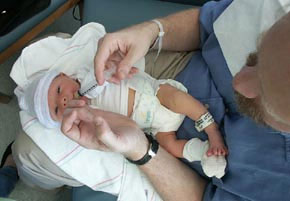

Researchers uncover one of the reasons people with low birth weights that later develop obesity have a greater risk of cardiac disease
Researchers uncover one of the reasons people with low birth weights that later develop obesity have a greater risk of cardiac disease
Researchers uncover one of the reasons people with low birth weights that later develop obesity have a greater risk of cardiac disease

Researchers uncover one of the reasons people with low birth weights that later develop obesity have a greater risk of cardiac disease
By Elton Alisson
Agência FAPESP – People with low birth weights, but that develop obesity during their childhood or adult life, have a higher risk of presenting cardiovascular disease and insulin resistance– a risk factor for diabetes.
One of the reasons for this association, highlighted in several studies over recent years and that still has not been clearly explained, could relate to alterations in the levels of protein (adipocytokines), produced by the adipose tissues and that function as protection factors, or inversely as risk factors, for cardiovascular diseases.
Researchers from Universidade Federal de São Paulo (Unifesp) made the discovery in a project, funded in part by FAPESP. The study involved an evaluation of 547 children aged 6 -12 years, from a municipal school in Embu, Greater São Paulo. Researchers categorized the birth weight, family history of heart disease, nutritional state, arterial pressure, and the profile of lipids, glycemia, insulin and adipocytokines, among other indicators.
Through lab exams, the researchers found that 30% of the children were either extremely overweight or obese, associated with factors like an increase in cholesterol and arterial pressure. Children with lower birth weights presented higher levels of triglycerides, uric acid and HOMA indexes, which is related to insulin resistance.
Based on the comparison of obese or overweight children with low birth weights with those that had normal birth weights, the researchers observed that the former had lower levels of certain adiponectins – a class of adipocytokines that protect against type 2 diabetes and cardiovascular disease.
But the first group presented higher levels of adipocytokines, which act as inflammatory markers and endothelials and are indicators of risk of cardiovascular disease. “With this we managed to partially verify an association between low birth weight and higher risk for cardiovascular disease in adult life,” commented Maria Wany Louzada Strufaldi, Unifesp professor and project coordinator, in an interview with Agência FAPESP.
According to her, the research opens a new perspective to explain the inflammatory aspect of the association between low birth weight with overweight or obesity and risk for heart disease, the mechanisms of which still are not clear.
“No one knows exactly which child will develop cardiovascular disease. We know the risk factors, but the moment this could occur or even if it will occur, is still not clear,” she said.
The researchers have also evaluated the levels of resistin presented by overweight or obese children with low birth weights. Previous studies indicated that resistin would have the opposite function of adiponectin. Nevertheless, in a new study, the protein was not identified as a risk or protection factor for cardiovascular disease and has not been proven to be associated with other inflammatory markers or birth weight in the children evaluated.
“This shows how complex it is to elucidate the mechanisms that are behind an association between low birth weight and obesity and increased risk of cardiovascular disease. There are many paths for us to attempt to uncover which factors can or cannot interfere in this question,” explained Strufaldi.
The Unifesp group intends to investigate whether the mechanism observed in the study can also be reproduced in an expressive manner with children having chronic illnesses, such as asthma. In doing so, they are attempting to find a physiopathological explanation for the possible inflammatory mechanisms associated with birth weight, which can also have clinical applications.
“Based on the increased prevalence of chronic disease, like obesity, diabetes and even asthma, these studies are important for pediatricians to identify warning signs and conduct earlier or more detailed exams in certain children,” says Strufaldi.
Republish
The Agency FAPESP licenses news via Creative Commons (CC-BY-NC-ND) so that they can be republished free of charge and in a simple way by other digital or printed vehicles. Agência FAPESP must be credited as the source of the content being republished and the name of the reporter (if any) must be attributed. Using the HMTL button below allows compliance with these rules, detailed in Digital Republishing Policy FAPESP.





